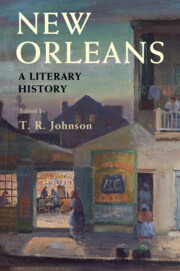Book contents
- New Orleans
- New Orleans
- Copyright page
- Dedication
- Contents
- Contributors
- Preface
- Acknowledgments
- Chapter 1 Swamp City
- Chapter 2 Mixed Motives
- Chapter 3 “As I Have Seen and Known It”
- Chapter 4 What New Orleans Meant to Walt Whitman
- Chapter 5 Coloring Sex, Love, and Desire in Creole New Orleans’s Long Nineteenth Century
- Chapter 6 The White Creole Tradition
- Chapter 7 The Civil War’s Literary Aftershocks
- Chapter 8 Illusion and Disillusion
- Chapter 9 Local Color, Social Problems, and the Living Dead in the Late-Nineteenth-Century Short Fiction of Alice Dunbar Nelson
- Chapter 10 Kate Chopin, Edna Pontellier, and the Predicament of the Intellectual Woman in New Orleans
- Chapter 11 Converging Americas
- Chapter 12 A Jazz Origin Myth
- Chapter 13 “Stepping Out” of the Storyville Frame
- Chapter 14 Louis Armstrong’s Autobiographical Art
- Chapter 15 New Orleans, Modernism, and The Double Dealer, 1921–1926
- Chapter 16 “Because What Else Could He Have Hoped to Find in New Orleans, If Not the Truth”
- Chapter 17 “The Place I Was Made For”
- Chapter 18 A Civil Rights–Era Novel of the American Civil War
- Chapter 19 How to Survive the Best Environments
- Chapter 20 Tom Dent and the Development of Black Literature in New Orleans
- Chapter 21 The Gothic Tradition in New Orleans
- Chapter 22 A Flaneur in the French Quarter and Beyond
- Chapter 23 Literary Fiction by New Orleans Women, 1961–2003
- Chapter 24 Asian American New Orleans
- Chapter 25 New Orleans Rap and Bounce
- Chapter 26 The Literature of Hurricane Katrina
- Chapter 27 Swan Song?
- Index
Chapter 8 - Illusion and Disillusion
The Making of Lafcadio Hearn
Published online by Cambridge University Press: 23 August 2019
- New Orleans
- New Orleans
- Copyright page
- Dedication
- Contents
- Contributors
- Preface
- Acknowledgments
- Chapter 1 Swamp City
- Chapter 2 Mixed Motives
- Chapter 3 “As I Have Seen and Known It”
- Chapter 4 What New Orleans Meant to Walt Whitman
- Chapter 5 Coloring Sex, Love, and Desire in Creole New Orleans’s Long Nineteenth Century
- Chapter 6 The White Creole Tradition
- Chapter 7 The Civil War’s Literary Aftershocks
- Chapter 8 Illusion and Disillusion
- Chapter 9 Local Color, Social Problems, and the Living Dead in the Late-Nineteenth-Century Short Fiction of Alice Dunbar Nelson
- Chapter 10 Kate Chopin, Edna Pontellier, and the Predicament of the Intellectual Woman in New Orleans
- Chapter 11 Converging Americas
- Chapter 12 A Jazz Origin Myth
- Chapter 13 “Stepping Out” of the Storyville Frame
- Chapter 14 Louis Armstrong’s Autobiographical Art
- Chapter 15 New Orleans, Modernism, and The Double Dealer, 1921–1926
- Chapter 16 “Because What Else Could He Have Hoped to Find in New Orleans, If Not the Truth”
- Chapter 17 “The Place I Was Made For”
- Chapter 18 A Civil Rights–Era Novel of the American Civil War
- Chapter 19 How to Survive the Best Environments
- Chapter 20 Tom Dent and the Development of Black Literature in New Orleans
- Chapter 21 The Gothic Tradition in New Orleans
- Chapter 22 A Flaneur in the French Quarter and Beyond
- Chapter 23 Literary Fiction by New Orleans Women, 1961–2003
- Chapter 24 Asian American New Orleans
- Chapter 25 New Orleans Rap and Bounce
- Chapter 26 The Literature of Hurricane Katrina
- Chapter 27 Swan Song?
- Index
Summary
New Orleans was central to the career of Lafcadio Hearn, the city where the young writer grew adept at explaining one culture to another – in this case, the downtown Creole culture of New Orleans to North American audiences – a skill that would serve him well when he moved to Japan. For Hearn, New Orleans signified the opposite of the mainstream US cultural values of materialism, commerce, progress, and efficiency – ideals he associated with the father who abandoned him. Instead, the city embodied the feminine, the exotic, the sensual, and a tropical lassitude that, for Hearn, became the opposite of modernity and in turn the essence of beauty.
Keywords
- Type
- Chapter
- Information
- New OrleansA Literary History, pp. 96 - 112Publisher: Cambridge University PressPrint publication year: 2019
- 1
- Cited by

